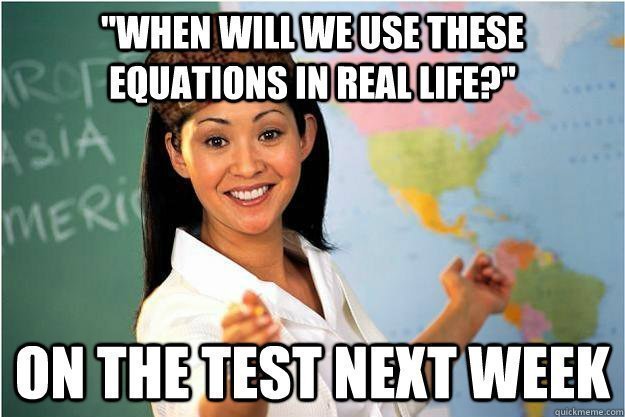
When am I gonna use this in real life? The application of dialogue.
One part of the New London Group’s revised 2003 article that immediately stood out to me was actually something they were quoting. They stated in the “Applications to Education” section:
“From the standpoint of the child, he observed, the great waste in the school comes from his inability to utilize the experiences he gets outside of the school in any complete and free way within the school itself; while on the other hand, he is unable to apply in daily life what he is learning in school (Dewey, 1899/1998; pp. 76-78).”
This immediately brought back memories of multiple classes for me in which we would ask the teacher in complete exasperation, “When are we ever going to use this in real life?” In one instance in my geography class, I specifically remember the teacher telling us, “You’re never going to use this, ever.” The complete absurdity of the situation fell heavy upon the whole class, and yet we were all stuck there “learning” regardless.
The answer lies within the education of the educators the article claims. Without claiming to understand all the complex backgrounds of all children and their specific needs and abilities, they use an approach described in a volume by Hull & Schultz. “Instead, they aim to provide us all, but especially those responsible for the education of children, with understanding of the principles underlying such variation and with help in listening to and appreciating what it is that children bring from home and community experience.”
“Indeed, the book consists of both articles about such experience and comments by teachers and teacher educators on their significance for learning. Here, then, NLS meets educational practice in ways that begin to fulfill the potential of the approach, but through dialogue rather than simply an imposition of researchers’ agendas on educators.”
So the solution is? Teach educators to enter into a dialogue about the complexities of a child’s literacy background and social placing to better understand a certain community’s and child’s needs and abilities both inside and outside of school. Because there is no cookie cutter solution that fits all students everywhere. Literacy and illiteracy is not a black and white thing. “The aim of such ‘applications’ has not been to simply impose a pre-given template on to local work in the field but to enter a dialogue.”
On another note, in reference to the video we were to watch, these were some interesting quotations I pulled out:
“With form separated from content, users did not need to know complicated code to upload content to the web.”
“The machine is us.”
“We are the web.”
I don’t think I have much to say, other than that literacy is an astounding thing, and digital literacy just takes it to a whole other level. We have created this amazing thing in the internet that allows for unprecedented communication and sharing. And it’s no longer exclusively for those who know technical computer jargon. Anyone can learn to use it. You can look up websites on how to learn to set up a website. It’s not simply complicated code anymore. It’s accessible. We control the organization. We control the information. We control the web. It’s a pretty amazing thing to think about. And it takes the idea of individual and social literacy to a whole other level as well. Who can do what and where and how well, and what is the role of digital literacy in classrooms, with economic and social implications as well? It’s too much for my brain to think about -__- But I think it’s a good thing:)

 Website:
Website: